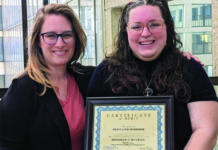Grand Junction’s film industry is small but growing. Local galleries, such as the Red Lion Arts Gallery and Studio, have begun to foster a place for the conversation of film as art, versus entertainment. Many different filmmakers and other leaders in the filmmaking community have weighed in about how they feel about film being considered art.
Christopher Michael is a local filmmaker, the founder of Running Director Productions and a member of the Western Slope Cinema Society. When asked about the subject of film as art, Michael mentioned collaboration as one of the most important factors.
“The best thing about film as an art form is something that I try to explain to other people as well. If I were to make a painting, it’s hours of my time, my passion [and] my creativity into a piece. It’s collectively mine, my expression, my feelings, things like that,” Michael said. “But with film, the great thing about it as an art form is you generally can’t do it by yourself. Even if I was like one person making a film myself, I would still need at least an actor or a subject or something there, to create.”
Michael worked on “Nightwing Returns: The Fan Series”, as well as other projects and collaborations over the years.
“I do consider film art. Seeing it as a medium, I find it more involved when you can combine not just one person’s idea and vision, but a group of people, and create a cumulative vision together,” Michael said.
According to Western Colorado Community College (WCCC) Digital Filmmaking Program Lead Dan McClintock, a chief reason that two part-time WCCC instructors came out to the Grand Valley is the relative cost of making a film here. A film that cost $100,000 in Southern California can be produced on the West Slope for $75,000.
“If you want provide food on your table, it has to be both,” McClintock said. “In our business, the two most significant things that will get our students jobs is their demo reel and professional contacts.”
CMU-TV General Manager, Brenna Rhiness, made a point about films mandated by studios versus those that are created on the terms of the artists involved.
“Some stories come from the creators [writers, directors, producers] themselves, and those I consider art. They have a certain commentary that isn’t always as apparent in large-corporation projects created solely to make money, those I would consider to be entertainment. Obviously, there are exceptions with each type,” Rhiness said.
Rhiness brought up films she enjoyed as art, such as “Good Will Hunting,” versus something better suited as a ‘popcorn flick’ like “Mission Impossible.”
“The enjoyment is different though, with films I would categorize as art, they tend to be more memorable. They evoke emotions that films I would place in the entertainment category do not. With the industry constantly changing, film can’t be put in a single medium. It bleeds into everything,” Rhiness said.
“Entertainment is fleeting, art is eternal,” Director of Red Lion Arts Jonathan Gosser said. “The film industry is a new venture for us, but we know it is growing locally. Through networking and collaborations with Christopher Michael, we are learning new and valuable information. We look forward to working with other producers and directors in the valley. The growth of the industry locally is exciting.”
Michael Byrne, a freelance actor from Chicago, who will be speaking at Red Lion Art Gallery on Feb. 14, weighed in on the issue.
“I would absolutely say that [film is art]. It’s a craft that’s accumulated from both experience and from embellishments. Obviously when you put things to a structure, or even just document things like they’re usually tied with a cohesive message, whether that message can be like a visual pattern for a personal reflection, it’s still one that’s created for the sake of finding residence, or at the very least, a catharsis,” Byrne said.
Local filmmaker and director, Preston Manee, said that art means a lot of different things to different people, and that’s because classifying something as art is so subjective, many different films can be considered art.
“Being able to say ‘this is art to me, this speaks to me on a different level,’ that is what film as art is, and it’s everything under the sun. And film as entertainment is a similar thing. I don’t know who’s watched Spy Kids, but there’s some deep messages there, and I would say that they spent a lot of time on some of the images there, and tried to create art out of that. For some people, it’s just going to be entertainment,” Manee said.
Manee also said that the collaborative nature of filmmaking, and the many different artistic aspects involved in the creation of a film, are what truly make filmmaking into an art.
“I think that film as art is this amazing collaborative effort, where everybody gives what they are an artist of collaboratively. You have great actors, great directors, great cinematographers, all collaborating to create these tiny little scenes, these tiny little fragments of time. A great director once said what is film, it’s actually a mosaic of time [. . .] And that is the true art of filmmaking right there,” Manee said.






